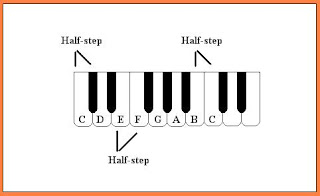Reading sheet music is like reading a foreign language. There are rules and patterns that must be followed for the music to sound pleasing to the ear and so the musician can interpret the music correctly in order to perform it.
Before we get to the music, we must first know how to write it correctly, and know how to organize it.
To learn about how to correctly label a note, head to: http://nomusicbflat.blogspot.com/2012/09/what-is-c4.html
To learn about clefs, head to:http://nomusicbflat.blogspot.com/2012/12/lesson-2-staffs-clefs-and-lines-oh-my.html
Now we will learn about the major scale, but to do that, we must first understand the difference between whole and half steps.
A half step is the difference in pitch from any key to the very next key(black and white keys included) up or down on a key board. It is the smallest musical interval. From C to C# is an ascending half step; from F to E is also a half step, but is descending.
A whole step is simply two adjacent half steps, and is the difference in pitch from any key to the key two keys away. From C to D is an ascending whole step (skips C#); from G# to F# is a descending whole step (skips G).
Now that we have learned what a half and whole step are, we can now fully understand what a whole scale is.
A scale is a series of notes in a pattern. There are two main types of scales used in modern music today: major (happy sounding) and minor (sad sounding) scales.
A major scale is a series of 8 notes made up of whole (W) and half (H) steps and played in a specific sequence. It's pattern is whole step-whole step-half step-whole step-whole step-whole step-half step, or W-W-H-W-W-W-H.
It looks like this:
...and it sounds like this**:
Do you hear how this sounds happy and upbeat? If you do, great!!! This is what most music you hear today is written in, a major key. If you don't hear it quite yet, don't worry, it will be easier once you hear the minor scale.
A minor scale is a series of eight notes and is also made up of whole (W) and half (H) steps and played in a specific sequence, however it's pattern is w-h-w-w-h-w-w.
It looks like this:
It looks like this:
...and it sounds like this**:
Do you hear how this sounds more melancholy and more somber than the first one? When you see a sad scene in a movie, like when one of the important characters dies, or when something bad just happened, you hear sad music. This music is in a minor key.
With either of these patterns, you can now create a scale starting on any note!!!! Just use the pattern and count half or whole steps to find each note. Once you have eight notes, if you got back to a note with the same name, but one octave higher, and it sounds right, then you know you have done it correctly.
Now you know how to tell the difference between a major and minor key when hearing it and seeing their patterns and how they work.You also know how to write a scale in any key signature (starting on any note).
This concludes the lesson for today.
*These were recordings of me playing a C major scale and an a natural minor scale on my flute, and FYI, I-pods make mp4 recordings and blogger only accepts video files. You would not BELIEVE how annoying these were to put on, although once I got them reformatted correctly, (thanks to my brother Nathan's help) they actually, (FINALLY) worked. I will definitely plan out more time to devote to getting videos working next time I add them to my blog posts.
*These were recordings of me playing a C major scale and an a natural minor scale on my flute, and FYI, I-pods make mp4 recordings and blogger only accepts video files. You would not BELIEVE how annoying these were to put on, although once I got them reformatted correctly, (thanks to my brother Nathan's help) they actually, (FINALLY) worked. I will definitely plan out more time to devote to getting videos working next time I add them to my blog posts.



No comments:
Post a Comment